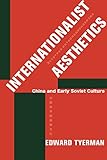Internationalist Aesthetics : China and Early Soviet Culture / Edward Tyerman.
Material type: TextPublisher: New York, NY : Columbia University Press, [2021]Copyright date: 2021Description: 1 online resource : 27 b&w figuresContent type:
TextPublisher: New York, NY : Columbia University Press, [2021]Copyright date: 2021Description: 1 online resource : 27 b&w figuresContent type: - 9780231199186
- 9780231552981
- 303.48/24705109042 23
- DK68.7.C5 T94 2022
- online - DeGruyter
| Item type | Current library | Call number | URL | Status | Notes | Barcode | |
|---|---|---|---|---|---|---|---|
 eBook
eBook
|
Biblioteca "Angelicum" Pont. Univ. S.Tommaso d'Aquino Nuvola online | online - DeGruyter (Browse shelf(Opens below)) | Online access | Not for loan (Accesso limitato) | Accesso per gli utenti autorizzati / Access for authorized users | (dgr)9780231552981 |
Frontmatter -- CONTENTS -- ACKNOWLEDGMENTS -- INTRODUCTION: CHINA AND EARLY SOVIET CULTURE -- 1. SIGHT, SOUND, AND SIMILARITY: SOVIET WRITERS TRAVEL TO CHINA -- 2. TRANSLATING CHINA ONSTAGE: ROAR, CHINA! AND THE RED POPPY -- 3. THROUGH AN INTERNATIONALIST LENS: CHINA IN EARLY SOVIET CINEMA -- 4. CONFESSIONS AND COLLABORATIONS: AUTHORITY, AGENCY AND FACTOGRAPHIC INTERNATIONALISM IN DEN SHI-KHUA -- EPILOGUE: INTERNATIONAL LITERATURE, NATIONAL FORM, AND MISSED CONNECTIONS -- NOTES -- BIBLIOGRAPHY AND SOURCES -- INDEX
restricted access online access with authorization star
http://purl.org/coar/access_right/c_16ec
Following the failure of communist revolutions in Europe, in the 1920s the Soviet Union turned its attention to fostering anticolonial uprisings in Asia. China, divided politically between rival military factions and dominated economically by imperial powers, emerged as the Comintern’s prime target. At the same time, a host of prominent figures in Soviet literature, film, and theater traveled to China, met with Chinese students in Moscow, and placed contemporary China on the new Soviet stage. They sought to reimagine the relationship with China in the terms of socialist internationalism—and, in the process, determine how internationalism was supposed to look and feel in practice.Internationalist Aesthetics offers a groundbreaking account of the crucial role that China played in the early Soviet cultural imagination. Edward Tyerman tracks how China became the key site for Soviet debates over how the political project of socialist internationalism should be mediated, represented, and produced. The central figure in this story, the avant-garde writer Sergei Tret’iakov, journeyed to Beijing in the 1920s and experimented with innovative documentary forms in an attempt to foster a new sense of connection between Chinese and Soviet citizens. Reading across genres and media from reportage and biography to ballet and documentary film, Tyerman shows how Soviet culture sought an aesthetics that could foster a sense of internationalist community. He reveals both the aspirations and the limitations of this project, illuminating a crucial chapter in Sino-Russian relations. Grounded in extensive sources in Russian and Chinese, this cultural history bridges Slavic and East Asian studies and offers new insight into the transnational dynamics that shaped socialist aesthetics and politics in both countries.
Mode of access: Internet via World Wide Web.
In English.
Description based on online resource; title from PDF title page (publisher's Web site, viewed 20. Nov 2024)


